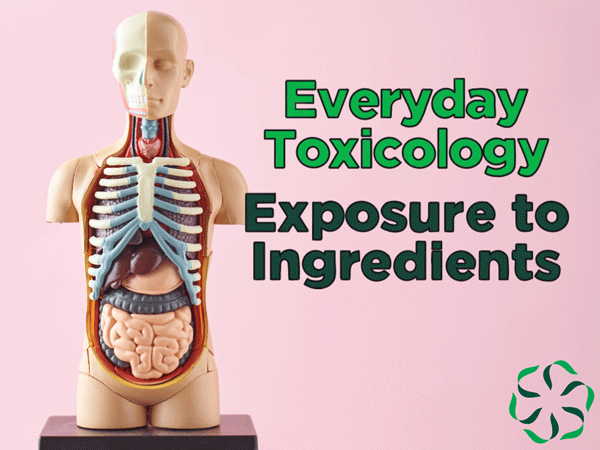We are exposed to ingredients every day in many different ways. In this post, we’ll explore how we’re exposed to ingredients and how different routes of exposure can change the health outcome.
What is exposure?
Exposure is the way we physically come in contact with an ingredient. We are exposed to many different ingredients and elements daily, most of which do not cause us harm. We are primarily exposed to ingredients via the food, beverages, medications, topical products, inhalants, and more we engage with daily.
What are the exposure routes?
These are the pathways that allow ingredients to enter our bodies. Primary exposure routes include our digestive tract through eating and drinking; respiratory tract by breathing; topically via our skin; and occasionally through our blood and eyes.
How does our body process different ingredients safely?
Our bodies possess sophisticated processes that can prevent common ingredients from causing harm unless exposure occurs at very high doses. Of course, there are exceptions, for example, in people who may be unusually sensitive to commonly safe ingredients as in the case of food allergies.
We know that ingredient safety depends on many factors including dose, purity, and more. In order to protect ourselves from harmful ingredients, many countries have established regulatory systems. In the U.S.A., the Food and Drug Administration (FDA), Department of Agriculture (USDA), and the Federal Trade Commission (FTC) use expert knowledge to help regulate the ingredients in the foods, beverages, cosmetics, medications, and more that we use and consume.
What happens when we’re exposed to something harmful?
Our bodies will react in many ways depending on the contaminant, toxin, or chemical compound exposed to our system. The reaction the body has will vary greatly depending on the exposure route, dose, and dose-rate.
For example, if we’re exposed to a food contaminant, we may experience unpleasant gastrointestinal symptoms that may or not be life-threatening, depending on the contaminant and the severity of the contamination. Again, symptoms and outcomes vary greatly depending on the ingredient, exposure route and most importantly, the dose.
Are all ingredients safe or harmful via all exposure routes?
No, ingredient safety and health outcomes vary greatly depending on the exposure route, dose, and dose-rate.
Let’s look at yams.
In some cases, foods contain natural compounds that can cause undesired effects. For example, Chinese yams need to be peeled carefully using gloves to avoid irritating the skin, but it’s perfectly safe to eat the yam, even raw, after the peeling process. For many yams found throughout Africa, you can safely peel the yam without gloves but must cook the yam to avoid adverse health effects from the uncooked yam.
The exposure routes and the processing of these ingredients determine the health outcome.
Let’s look at vitamin E acetate.
Vitamin E acetate is a Generally Recognized as Safe (GRAS) ingredient, which means it’s safe for typical human consumption because the digestive system can safely process this ingredient. It is also considered safe for use in many topical products such as lotions, soaps, and more because our skin processes it without adverse outcomes.
However, vitamin E acetate was added to vaping liquids as some manufacturers wrongly assumed the respiratory system could process it without issue. Unfortunately, the respiratory system cannot handle this ingredient, and it leads to severe, adverse health outcomes, including organ transplants and even death.
As you can see, the exposure route for vitamin E acetate dramatically changes the health outcome.
Let’s look at medications.
It’s crucial to take medications as directed because pharmacists design drugs to be processed by a specific bodily system. For example, a drug that’s meant to be processed through our digestive system should never be altered to be processed via our circulatory or respiratory systems, as this could lead to disastrous health outcomes.
Similarly, a medicine meant to be used topically on our skin or in our eyes, should not be consumed or inhaled because it could lead to deadly health outcomes.
What does this all mean?
Different systems in our bodies process ingredients and the compounds in those ingredients differently. This means it’s essential to understand that ingredients and products are only safe when used for their intended purposes.

